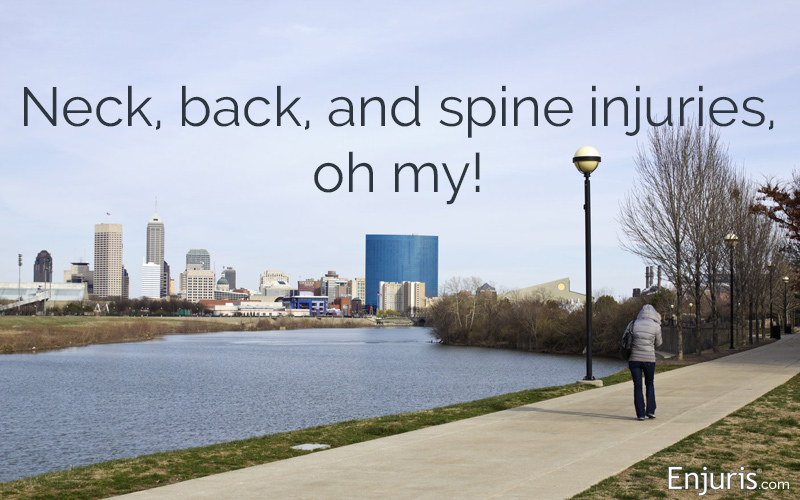What damages can be recovered when an accident causes an injury to your neck, back, or spine?
Don’t be alarmed, but some of your body parts are useless.
At the bottom of your spine is a bone that sticks out a bit called the coccyx (the tailbone). In animals that have tails, the tailbone helps to move the tail around. For you, the tailbone is useless.
Scientists call these no-longer-useful body parts “vestigial traits.”
Unlike your tailbone, your neck, back, and spine are critical to your daily functioning. They are the opposite of vestigial traits. As a result, injuries to these body parts can be catastrophic and often lead to complex litigation and high damage awards.
Let’s take a closer look at neck, back, and spine injuries in Indiana.
Common neck, back, and spine injuries
Let’s start with a brief anatomy lesson:
Your spine is made up of 33 small bones called vertebrae. These bones begin at your neck, spread through your lower back, and end at your tailbone. Your vertebrae support your head and allow you to stand up and maintain your balance. Between each of your vertebrae are spinal discs that absorb shock and help make your spine flexible.
An injury to any part of your spine will almost certainly be felt in both your neck and back. Similarly, an injury to your neck will often be felt in your back, and vice versa.
Some of the most common neck, back, and spine injuries include:
- Spinal trauma. Damage to any part of the spinal cord or the nerves at the end of the spinal canal will often result in permanent changes in strength, sensation, and other bodily functions below the site of the injury.
- Whiplash. Whiplash is a neck injury caused by the forceful, back-and-forth movement of the neck. Whiplash is commonly caused by rear-end car accidents but can result from other accidents as well, including football accidents.
- Pains and strains. Certain impacts may cause muscle strains or ligament sprains in the neck or back.
- Pinched nerve. A pinched nerve (also known as a “stinger” or “burner”) occurs when a pinched nerve in the neck produces a sharp, shooting sensation in the neck and arms.
- Herniated disk. A herniated disk occurs when the center of a spinal disk pushes through the rubbery exterior. A herniated disk can irritate a nearby nerve, resulting in pain, numbness, or weakness.
Causes of neck, back, and spine injuries
Unfortunately, just about any activity could lead to a neck, back, or spine injury. There are, however, certain activities and accidents that are particularly likely to cause a neck, back, or spine injury:
- Defective products
- Construction accidents
- Intentional acts of violence (gunshot wounds or stabbings)
- Slip and falls
- Sports (particularly football and swimming)
Carson Rainey was a 15-year-old elite hockey player in the Indianapolis Youth Hockey Association when he was involved in a life-changing accident.
Carson was traveling to a hockey game in his father’s SUV. Because they had to leave early in the morning, Carson pushed the seats of the vehicle down and curled up to get some extra sleep while his father drove.
On Interstate 70, Carson’s father hit a patch of black ice. The SUV began to fishtail and was hit by a semi-truck.
Carson was thrown 40 feet from the car and landed on the road. He was taken to Dayton Children’s Hospital, where doctors informed him that he had fractured the C-7 vertebrae in his neck and damaged 3 vertebrae on his spine.
Carson’s recovery has been remarkable and he’s now able to walk on his own with a crutch.
Legal claims based on neck, back, and spine injuries
If you suffer a neck, back, or spine injury, you may be able to recover damages by filing a legal claim. The type of legal claim you file depends on the nature of your injury.
Negligence lawsuit
If your neck, back, or spine injury was caused by someone else’s carelessness, you may be able to recover damages by filing a personal injury lawsuit based on negligence.
In Indiana, a plaintiff must prove 3 elements to establish negligence:
- The defendant owed the plaintiff a duty of care,
- The defendant breached the duty of care, and
- The defendant’s breach was the cause of the injury.
Generally speaking, people are required to adhere to a standard of reasonable care while performing acts that could foreseeably harm others. For example, all drivers must exercise reasonable care while operating their vehicles. If a driver breaches this standard of care (for example, by texting and driving), the driver may be negligent.
In some cases, people owe a standard of care even higher than reasonable care. For example, common carriers (those who transport others for money, such as bus drivers and taxi drivers) in Indiana are required to exercise the highest degree of care to keep their passengers safe.
Workers’ compensation claim
If you suffer a neck, back, or spine injury as a result of a workplace accident, you may be able to file a workers’ compensation claim.
Workers’ compensation is a type of insurance that provides financial benefits to injured workers. In Indiana, most employers are required to carry workers’ compensation insurance.
What’s more, most injuries are covered regardless of how the injury happens. In other words, unlike personal injury lawsuits, there’s no need to prove that someone was at fault.
Intentional tort lawsuit
If someone intentionally causes your neck, back, or spine injury, you may be able to file a personal injury lawsuit against them based on an intentional tort.
Common intentional torts include battery and assault.
Damages available for neck, back, and spine injuries in Indiana
The goal of damages is to make you whole. In other words, the court is supposed to award the amount of money necessary to cover the losses caused by your injury. These losses may be financial or emotional, and therefore you may be entitled to both economic and non-economic damages.
Economic damages
Economic damages compensate you for all the damage that has an objective monetary value. In neck, back, and spine injury cases this may include:
- Medical expenses (surgeries, physical therapy, home care, etc.)
- Lost wages (including future lost wages)
- Property damage
Living with a spinal cord injury can be particularly expensive. Here are the average lifetime expenses:
| Estimated lifetime cost of a spinal injury | ||
|---|---|---|
| Severity of injury | 25 years old | 50 years old |
| High tetraplegia (C1-C4) | $4.7 million | $2.6 million |
| Low tetraplegia (C5-C8) | $3.5 million | $2.1 million |
| Paraplegia | $2.3 million | $1.5 million |
| Incomplete motor function (any level) | $1.5 million | $1.1 million |
Non-economic damages
Non-economic damages compensate you for all the damages that don’t have an objective monetary value, such as:
- Pain and suffering. Physical pain is subjective and insurance companies, judges, and juries must rely on a number of factors to determine the value of your pain and suffering. These factors include the type of injury and the length of recovery.
- Emotional distress. Indiana allows compensation for emotional distress (sometimes called “mental anguish”). Just like pain and suffering, emotional distress is difficult to put a price tag on. Insurance companies, judges, and juries generally consider the nature of the injury and the impact it has had on your day-to-day life (loss of sleep, depression, etc.) when determining how much to award.
- Loss of consortium. If you’re married at the time of your accident, your spouse may be able to recover loss of consortium damages. Loss of consortium damages are meant to help make up for the often negative impact of the injury on your relationship.
Do I need to hire an Indiana injury lawyer?
Most people who suffer a neck, back or spine injury benefit greatly from an attorney. Neck, back, and spine injuries are complex and there’s often a lot of money at stake. As a result, insurance companies and defense attorneys almost always gather experts to argue that your injury wasn’t caused by the accident or that your injury is not as bad as you claim.
A good plaintiff’s attorney can gather the necessary evidence to weave together an emotional and convincing narrative about your injury and the impact it’s had on your day-to-day life.
You can find an experienced personal injury attorney in our free online directory.
See our guide Choosing a personal injury attorney.


